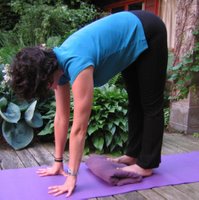
One of the reasons I prefer Iyengar yoga, and like to teach it, is that each pose is its own entity. You establish your correct position and alignment and then stay there, keenly aware of the work necessary to achieve the pose and the benefits derived from that work. You can’t use momentum or sneak out of the more difficult poses; it’s your mind and your muscles present in that particular moment. Of course, how do you know if you are in the pose correctly so you are helping your body, not hurting it? Well, first of all, you should try to have a class with a trained teacher every once and awhile so s/he can help you do each asana correctly. When you are on your own, here are a few tricks to doing your own adjustments.
-Trikonasana (Triangle): from the side, check the squareness of the hips and the line-up of knee and top of foot
-Virabhadrasana II (Warrior 2): same as Triangle, also check the level of the arms
-Parsvakonasana (Lateral Angle): same as Warrior 2, from the front check for a straight line from ankle to wrist
-Any sitting pose: from the side you can look at the line-up of ears, shoulders and hips; from the front you can check to see if the hips and knees are level
-Forward bends: from the side you can make sure the spine is long and you are folding from the hip crease
-Twists: make sure the head is lined up with the tailbone and you aren’t leaning back, that the chin is parallel to floor
 Another possibility, which usually requires an assistant, is to take a picture of yourself doing the pose. This doesn’t offer immediate adjustment possibilities, but with more angles to look at, you get a better sense of the whole pose (digital is semi-immediate). I present two versions of Uttanasana (Standing Forward Bend) as an example: In the first picture, you can see my hips are too far back which means I’m not grounding evenly through my feet. This lifts my hands off the floor and I’m also rounding my back slightly to help balance. In the second photo, I’ve brought my hips forward and now my hands can press to the floor so the arms are more engaged and my spine lengthens. I didn’t stage the first photo—after checking it on the camera, I realized what needed adjusting. I have to admit, taking a lot of pictures for this blog has made me very aware of the fine tuning required in even the most basic of poses!
Another possibility, which usually requires an assistant, is to take a picture of yourself doing the pose. This doesn’t offer immediate adjustment possibilities, but with more angles to look at, you get a better sense of the whole pose (digital is semi-immediate). I present two versions of Uttanasana (Standing Forward Bend) as an example: In the first picture, you can see my hips are too far back which means I’m not grounding evenly through my feet. This lifts my hands off the floor and I’m also rounding my back slightly to help balance. In the second photo, I’ve brought my hips forward and now my hands can press to the floor so the arms are more engaged and my spine lengthens. I didn’t stage the first photo—after checking it on the camera, I realized what needed adjusting. I have to admit, taking a lot of pictures for this blog has made me very aware of the fine tuning required in even the most basic of poses!
While it’s important to check the accuracy of your poses, don’t get too bogged down in being “correct.” As you continue to practice, your body will learn where it should place itself and you will come to the position automatically and then do fine tuning once you are in place. This subtle work you do while in the pose is the essence of yoga; your awareness of your body in each asana in each specific moment. You won’t need a mirror to tell you who is the fairest in the land; you will know it in your heart. O Great Queen (or King)! ©Brenda K. Plakans. All Rights Reserved.

1 comment:
I like the mirror where we practice too - as we know I've staked my claim up front. (lol). I'm so short I couldn't see a thing in back - and I mean nothing - you or the mirror. I guess though as I get better I need to give up mirror space to someone else just starting off.
Post a Comment